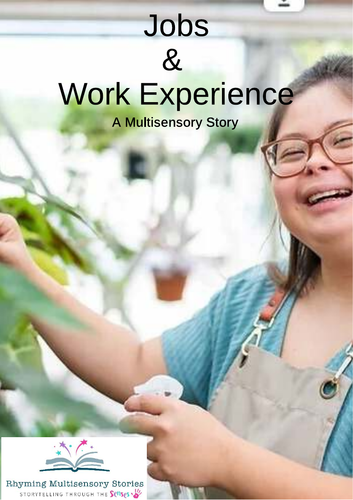

Told as a multisensory story, this resource explores the world of jobs and work experience.
The extension activities are set up to appeal to appeal to a range of ages and abilities.
Early Years and Reception and Year 1 students can explore the world of work through role play and classroom based activities.
PMLD students can explore the world of work through the sensory props and themed activities.
For post-16 students there are ideas for work experience within the whole school and suggestions for where to look for work placements in the wider community.
A multisensory story is told using sensory stimuli (props).
The story props are low budget, everyday items found around the home, garden, outdoor areas and in the classroom.
This story includes themed, sensory extension activities that link to the EYFS Framework and areas of the KS1 National Curriculum making them the perfect resource for Special Education (aged 3-19) EYFS, Mainstream Primary, Speech & Language and EAL students.
Table of Contents
Introduction
The Benefits of Multisensory Storytelling
How to Tell a Multisensory Story
Story Props Checklist
Fully Resourced, Step-by-Step Multisensory Story
The Coffee Shop
The Library
The Charity Shop
The Garden Centre
The Hair Salon
The Pet Store
College
Classroom Job Board
Whole School/Setting Job Board
The Interview
What are the Benefits of Multisensory Storytelling?
-
Storytelling creates a bond between the storyteller and the story explorer enhancing and enriching experiences.
-
Rhyming Multisensory Stories connect the individual to literature, culture and topic in a fun and engaging way.
-
The stories form a base on which to scaffold learning enabling the student to work on personal goals and individual targets.
-
The activities in the stories are designed to promote communication skills: (eye contact, listening, shared attention & language development), self-confidence & well-being (trying out new ideas & skills, practicing self-care & independence and enjoying achievement), self-awareness: (asking for ‘help’, ‘again’ and ‘more’), present opportunities to explore cause & effect and build anticipation skills, promote physical development: (fine & gross motor skills), build knowledge about the environment & the world around us, to engage in scientific experimentation and mathematical concepts and to develop social & emotional skills: (turn-taking & sharing and teamwork).
-
The sensory stimuli (story props) are a tool for the story explorer to explore and express their likes, dislikes and sensory preferences and to have the opportunity to make choices.
This information can be used to identify motivators or items to calm and individual when anxious, tired or stressed, identify triggers, (some you may wish to avoid, others to work on building tolerance through desensitisation in a safe and therapeutic environment) and used in the writing of care plans to enhance areas daily life.
Thank you for looking:)
Something went wrong, please try again later.
This resource hasn't been reviewed yet
To ensure quality for our reviews, only customers who have purchased this resource can review it
Report this resourceto let us know if it violates our terms and conditions.
Our customer service team will review your report and will be in touch.